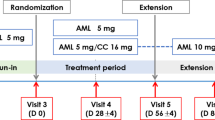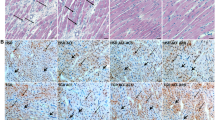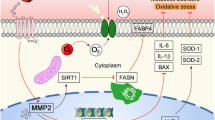Abstract
Although recent clinical studies have suggested that long-acting calcium channel blockers (CCBs) have beneficial effects on heart failure, the precise mechanism is unknown. In this study, Dahl salt-sensitive rats fed a high salt diet were treated with the long-acting CCB amlodipine, the low–molecular-weight membrane permeable superoxide dismutase mimetic 4-hydroxy-2,2,6,6-tetramethyl piperidinoxyl (Tempol), or saline from 11 weeks after birth. The cardiac geometry and function, and gene expression profiles were determined at 17 weeks. Dahl salt-sensitive rats fed a high salt diet followed by saline as a non-treatment control (HS group) showed a marked increase in blood pressure and developed concentric hypertrophy at 11 weeks, followed by left ventricular (LV) dilation and congestive heart failure by 17 weeks. The treatment with amlodipine (AMLO group) or Tempol (TEMP group) significantly inhibited the development of LV hypertrophy and cardiac dysfunction. Analysis using an Affymetrix GeneChip U34 revealed that the expression levels of 195 genes were changed by the treatment with amlodipine. Among these 195 genes, 110 genes were increased in HS rats and decreased in AMLO rats. And of these 110 genes, 54 genes were also decreased in TEMP rats. In contrast, 85 genes were decreased in HS rats and increased in AMLO rats. Of these 85 genes, 38 genes were also increased in TEMP rats. Approximately 48% of the genes were changed in similar fashion in AMLO and TEMP rats, suggesting that amlodipine shows beneficial effects on heart failure mainly via antioxidative mechanisms.
Similar content being viewed by others
Article PDF
References
Levy D, Garrison RJ, Savage DD, et al: Prognostic implications of echocardiographically determined left ventricular mass in the Framingham Heart Study. N Engl J Med 1990; 322: 1561–1566.
Frohlich ED : Cardiac hypertrophy in hypertension. N Engl J Med 1987; 317: 831–833.
Katz AM : The cardiomyopathy of overload: an unnatural growth response in the hypertrophied heart. Ann Intern Med 1994; 121: 363–371.
Tavi P, Laine M, Weckstrom M, et al: Cardiac mechanotransduction: from sensing to disease and treatment. Trends Pharmacol Sci 2001; 22: 254–260.
Komuro I : Molecular mechanism of cardiac hypertrophy and development. Jpn Circ J 2001; 65: 353–358.
Chobanian AV, Bakris GL, Black HR, et al, National Heart, Lung, and Blood Institute Joint National Committee on Prevention, Detection, Evaluation, and Treatment of High Blood Pressure; National High Blood Pressure Education Program Coordinating Committee: The Seventh Report of the Joint National Committee on Prevention, Detection, Evaluation, and Treatment of High Blood Pressure: the JNC 7 report. JAMA 2003; 289: 2560–2572.
Wilcox RG, Hampton JR, Banks DC, et al: Trial of early nifedipine in acute myocardial infarction: the Trent study. Br Med J 1986; 293: 1204–1208.
The Israeli Sprint Study Group: Secondary prevention reinfarction Israeli nifedipine trial (SPRINT). A randomized intervention trial of nifedipine in patients with acute myocardial infarction. Eur Heart J 1988; 9: 354–364.
Furberg CD, Psaty BM, Meyer JV : Nifedipine. Dose-related increase in mortality in patients with coronary heart disease. Circulation 1995; 92: 1326–1331.
Spinale FG, Mukherjee R, Krombach RS, et al: Chronic amlodipine treatment during the development of heart failure. Circulation 1998; 98: 1666–1674.
Lubsen J, Wagener G, Kirwan BA, et al: Effect of long-acting nifedipine on mortality and cardiovascular morbidity in patients with symptomatic stable angina and hypertension: the ACTION trial. J Hypertens 2005; 23: 641–648.
Poole-Wilson PA, Lubsen J, Kirwan BA, et al: Effect of long-acting nifedipine on mortality and cardiovascular morbidity in patients with stable angina requiring treatment (ACTION trial): randomised controlled trial. Lancet 2004; 364: 849–857.
Mason RP, Campbell SF, Wang SD, Herbette LG : Comparison of location and binding for the positively charged 1,4-dihydropyridine calcium channel antagonist amlodipine with uncharged drugs of this class in cardiac membranes. Mol Pharmacol 1989; 36: 634–640.
Zhang X, Hintze TH : Amlodipine releases nitric oxide from canine coronary microvessels: an unexpected mechanism of action of a calcium channel–blocking agent. Circulation 1998; 97: 576–580.
Cominacini L, Pasini AF, Pastorino AM, et al: Comparative effects of different dihydropyridines on the expression of adhesion molecules induced by TNF-alpha on endothelial cells. J Hypertens 1999; 17: 1837–1841.
Ikeda U, Hojo Y, Ueno S, Arakawa H, Shimada K : Amlodipine inhibits expression of matrix metalloproteinase-1 and its inhibitor in human vascular endothelial cells. J Cardiovasc Pharmacol 2000; 35: 887–890.
Mason RP, Marche P, Hintze TH : Novel vascular biology of third-generation L-type calcium channel antagonists: ancillary actions of amlodipine. Arterioscler Thromb Vasc Biol 2003; 23: 2155–2163.
Rapp JP, Wang SM, Dene H : A genetic polymorphism in the renin gene of Dahl rats cosegregates with blood pressure. Science 1989; 243: 542–544.
Inoko M, Kihara Y, Morii I, et al: Transition from compensatory hypertrophy to dilated, failing left ventricles in Dahl salt-sensitive rats. Am J Physiol 1994; 267: H2471–H2482.
Inoko M, Kihara Y, Sasayama S : Neurohumoral factors during transition from left ventricular hypertrophy to failure in Dahl salt-sensitive rats. Biochem Biophys Res Commun 1995; 206: 814–820.
Iwanaga Y, Kihara Y, Hasegawa K, et al: Cardiac endothelin-1 plays a critical role in the functional deterioration of left ventricles during the transition from compensatory hypertrophy to congestive heart failure in salt-sensitive hypertensive rats. Circulation 1998; 98: 2065–2073.
Nishikawa N, Masuyama T, Yamamoto K, et al: Long-term administration of amlodipine prevents decompensation to diastolic heart failure in hypertensive rats. J Am Coll Cardiol 2001; 38: 1539–1545.
Duggan DJ, Bittner M, Chen Y, Meltzer P, Trent JM : Expression profiling using cDNA microarrays. Nat Genet 1999; 21: 10–14.
Shiffman D, Porter JG : Gene expression profiling of cardiovascular disease models. Curr Opin Biotechnol 2000; 11: 598–601.
Hasegawa H, Yamamoto R, Takano H, et al: 3-Hydroxy-3-methylglutaryl coenzyme A reductase inhibitors prevent the development of cardiac hypertrophy and heart failure in rats. J Mol Cell Cardiol 2003; 35: 953–960.
Shimoyama M, Hayashi D, Zou Y, et al: Calcineurin inhibitor attenuates the development and induces the regression of cardiac hypertrophy in rats with salt-sensitive hypertension. Circulation 2000; 102: 1996–2004.
Liu YH, Carretero OA, Cingolani OH, et al: Role of inducible nitric oxide synthase in cardiac function and remodeling in mice with heart failure due to myocardial infarction. Am J Physiol Heart Circ Physiol 2005; 289: H2616–H2623.
Ishii M, Hashimoto S, Tsutsumi S, et al: Direct comparison of GeneChip and SAGE on the quantitative accuracy in transcript profiling analysis. Genomics 2000; 68: 136–143.
Lockhart DJ, Dong H, Byrne MC, et al: Expression monitoring by hybridization to high-density oligonucleotide arrays. Nat Biotechnol 1996; 14: 1675–1680.
Lee CK, Klopp RG, Weindruch R, et al: Gene expression profile of aging and its retardation by caloric restriction. Science 1999; 285: 1390–1393.
Mizukami M, Hasegawa H, Kohro T, et al: Gene expression profile revealed different effects of angiotensin II receptor blockade and angiotensin-converting enzyme inhibitor on heart failure. J Cardiovasc Pharmacol 2003; 42: S1–S6.
Ikeda S, Hamada M, Qu P, et al: Relationship between cardiomyocyte cell death and cardiac function during hypertensive cardiac remodelling in Dahl rats. Clin Sci 2002; 102: 329–335.
Shioi T, Matsumori A, Kihara Y, et al: Increased expression of interleukin-1 beta and monocyte chemotactic and activating factor/monocyte chemoattractant protein-1 in the hypertrophied and failing heart with pressure overload. Circ Res 1997; 81: 664–671.
Elmedal B, de Dam MY, Mulvany MJ, et al: The superoxide dismutase mimetic, tempol, blunts right ventricular hypertrophy in chronic hypoxic rats. Br J Pharmacol 2004; 141: 105–113.
Zhang GX, Kimura S, Nishiyama A, et al: Cardiac oxidative stress in acute and chronic isoproterenol-infused rats. Cardiovasc Res 2005; 65: 230–238.
Yoshida K, Kim-Mitsuyama S, Wake R, et al: Excess aldosterone under normal salt diet induces cardiac hypertrophy and infiltration via oxidative stress. Hypertens Res 2005; 28: 447–455.
Yamamoto K, Masuyama T, Sakata Y, et al: Roles of renin-angiotensin and endothelin systems in development of diastolic heart failure in hypertensive hearts. Cardiovasc Res 2000; 47: 274–283.
Hayashida W, Kihara Y, Yasaka A, Sasayama S : Cardiac calcineurin during transition from hypertrophy to heart failure in rats. Biochem Biophys Res Commun 2000; 273: 347–351.
Iwanaga Y, Kihara Y, Inagaki K, et al: Differential effects of angiotensin II versus endothelin-1 inhibitions in hypertrophic left ventricular myocardium during transition to heart failure. Circulation 2001; 104: 606–612.
Mason RP, Walter MF, Trumbore MW, Olmstead EG Jr, Mason PE : Membrane antioxidant effects of the charged dihydropyridine calcium antagonist amlodipine. J Mol Cell Cardiol 1999; 31: 275–281.
Umemoto S, Tanaka M, Kawahara S, et al: Calcium antagonist reduces oxidative stress by upregulating Cu/Zn superoxide dismutase in stroke-prone spontaneously hypertensive rats. Hypertens Res 2004; 27: 877–885.
Wen Y, Gu J, Peng X, Zhang G, Nadler J : Overexpression of 12-lipoxygenase and cardiac fibroblast hypertrophy. Trends Cardiovasc Med 2003; 13: 129–136.
Niederau C, Schonberg M : New developments in the pathophysiology of inflammatory pancreatic disease. Hepatogastroenterology 1999; 46: 2722.
Raposo B, Rodriguez C, Martinez-Gonzalez J, Badimon L : High levels of homocysteine inhibit lysyl oxidase (LOX) and downregulate LOX expression in vascular endothelial cells. Atherosclerosis 2004; 177: 1–8.
Poon HF, Vaishnav RA, Butterfield DA, et al: Proteomic identification of differentially expressed proteins in the aging murine olfactory system and transcriptional analysis of the associated genes. J Neurochem 2005; 94: 380–392.
Baumann R, Casaulta C, Simon D, Conus S, Yousefi S, Simon HU : Macrophage migration inhibitory factor delays apoptosis in neutrophils by inhibiting the mitochondria-dependent death pathway. FASEB J 2003; 17: 2221–2230.
Leng L, Metz CN, Fang Y, et al: MIF signal transduction initiated by binding to CD74. J Exp Med 2003; 197: 1467–1476.
Xiang G, Schuster MD, Seki T, et al: Down-regulation of plasminogen activator inhibitor 1 expression promotes myocardial neovascularization by bone marrow progenitors. J Exp Med 2004; 200: 1657–1666.
Author information
Authors and Affiliations
Corresponding author
Rights and permissions
About this article
Cite this article
Hasegawa, H., Takano, H., Kohro, T. et al. Amelioration of Hypertensive Heart Failure by Amlodipine May Occur via Antioxidative Effects. Hypertens Res 29, 719–729 (2006). https://doi.org/10.1291/hypres.29.719
Received:
Accepted:
Issue date:
DOI: https://doi.org/10.1291/hypres.29.719
Keywords
This article is cited by
-
Xyloketal B exerts antihypertensive effect in renovascular hypertensive rats via the NO-sGC-cGMP pathway and calcium signaling
Acta Pharmacologica Sinica (2018)



